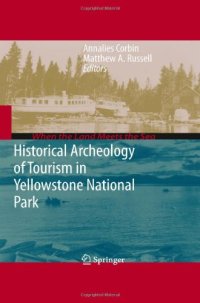
Ebook: Historical Archeology of Tourism in Yellowstone National Park
- Tags: Archaeology, Cultural Heritage
- Series: When the Land Meets the Sea
- Year: 2010
- Publisher: Springer-Verlag New York
- Edition: 1
- Language: English
- pdf
Tourism represents the largest movement of human populations outside of wartime, making it a powerful force for cultural contact and change. The contributors to this comprehensive volume apply an archaeological study of tourism to their investigation of Yellowstone National Park - one of the largest and most popular tourist destinations in the United States.
This volume contains three studies that trace the history of tourism in Yellowstone National Park through material remains discovered in both terrestrial and underwater archeological sites. A research approach with an archeological foundation opens new avenues of inquiry not available by using historical documents alone. Incorporating archeological materials into our interpretations of historical tourism in Yellowstone can help counter research biases that hamper use of a sometimes-fragmentary archival record. Archeology gives voice to people otherwise missing from written history, and therefore give us the broadest view of the past.
These chapters draw together the fascinating historical archeology of Yellowstone National Park into a single volume linked by a common research framework, the archeology of tourism. While oftentimes treated as separate and unrelated resources, historical archeological sites on land, underwater, and in the liminal zone in between, connect in Yellowstone through a shared history and a universal purpose. Situating these sites within the context of a larger tourist infrastructure allows us to broaden our interpretation and enriches the stories the sites have to tell.
The techniques and conclusions of these studies will be of interest to archaeologists and cultural resource and heritage managers working within national parks in the US and elsewhere. It will also be of interest to archaeologists focused on public archaeology, tourism.
This volume contains three studies that trace the history of tourism in Yellowstone National Park through material remains discovered in both terrestrial and underwater archeological sites. A research approach with an archeological foundation opens new avenues of inquiry not available by using historical documents alone. Incorporating archeological materials into our interpretations of historical tourism in Yellowstone can help counter research biases that hamper use of a sometimes-fragmentary archival record. Archeology gives voice to people otherwise missing from written history, and therefore give us the broadest view of the past. These chapters draw together the fascinating historical archeology of Yellowstone National Park into a single volume linked by a common research framework, the archeology of tourism. While oftentimes treated as separate and unrelated resources, historical archeological sites on land, underwater, and in the liminal zone in between, connect in Yellowstone through a shared history and a universal purpose. Situating these sites within the context of a larger tourist infrastructure allows us to broaden our interpretation and enriches the stories the sites have to tell.